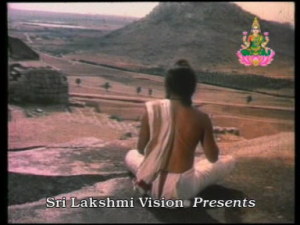Hamsageethe tells the story of a Carnatic singer from the time he wants to completely devote himself to the art till the time he puts an end to it. Based on a novel by T. R. Subba Rao (commonly known as Ta Ra Su), G. V. Iyer directed this film with Anant Nag in the main role.

Set in Chitradurga, around the last years of the Palegar rule, Venkatasubbaiah walks into a temple at an unearthly hour pleading divine help to sort his relationship with his guru. It is evident from the beginning that the young man is way too talented and devoted to be just another normal singer. But he is also demure to a fault and lets himself flow with the wind of the day. When he is challenged by his guru, he submits himself to his art and attains levels of excellence that stuns experts and commoners alike. When he goes in search of a new guru after a misfortune and spots a drunk singer lost to waste, he tugs at his sacred thread before buying alcohol for him, like one would grit teeth before gulping down some bitter medicine. It takes him not more than a few rounds of applause from the king to become arrogant and just as easily, he is embarrassed off it by a heckling audience.
The story of Venkatasubbaiah is a collection of dramatic ups and downs between his states of complete devotion to a difficult art. Either the VCD was drastically cut or the crew had to work with very low budgets, quite a lot of these dramatic ups and downs happen rather abruptly. With very little dialogue, plenty of music by Balamurali Krishna, enough handheld camera work and a rapidly changing life-graph of the protagonist, Hamsageethe is watchable and dare I say even entertaining. Yet, you can see budget was not kind to the film. Every time a segment is left to grow itself, the film is engrossing, like in the first few minutes where Venkatasubbaiah overcomes his guru’s anger with an ingenious rendition. But as the story moves, the need to cover much of the aspects of the book take a toll.
Anant Nag has all of twenty seconds to do something with his eyes to show Venkatasubbaiah’s submission to hubris. G V Iyer helps him with a double round of applause from king and commoners alike to quickly twist a well-constructed, likable character into a a self-absorbed, cynical one. When his guilt towards neglecting his mother takes him out into the hills, a lot of it is done just as abruptly and you wish there was more light on the peripheral characters like that of his uncle whose life is constant against his nephew’s volatile existence.

Thinking about some of the elements of the film, you’d feel it needed more freedom in production. However, at almost all these times, the music makes up for a jerky camera or a hurried scene. The poignancy of this most devoted of artists, pledging two of his beloved raagas for money would have been lost had the strain of a veene not accompanied a voice flashback. As mentioned, there are plenty of songs and even a dance face-off. Luckily, there are no RTPs to put you to sleep.
I have a lot of time for such films, that come with a clear intent to tell a story. Theatrical influence is evident, but not in the way the actors act. Anant Nag does enough for a role which demands more thought than histrionics. However, neither he, nor anyone else convinces in their roles as proper Carnatic singers. It is tough enough to do with many takes, but here, I presume the director couldn’t afford many. Talking of whom, I must scour the shelves for Bhagavad Gita (Sanskrit, National Award winner) and Adi Shankaracharya (a film Derek Malcolm apparently felt was way ahead of its times).


Sounds like a film of substance. You have a scathing pen!
The film is good. Not sure you’d get a copy of this in the north of India though.
Great write up. Wish you had included some audio clips. It is strange that in a musical saga of this kind, the director GV Iyer did not have a single Kannada song. All the songs were Jayadeva ashtapadi’s – there’s no connection between a singer like Venkanna in Chitradurga and Jayadeva. He’s not known to be a Krishna worshipper either. This has got to be a big musical lacuna in the movie. Other than that, I don’t think he has developed the character of Venkanna very well. The end is kind of abrupt. Balamurali Krishna’s singing is what has lifted the movie up.
Thanks so much for the reply. Adds a lot to the essay. Not being a Carnatic music enthusiast, I missed all of this.
But it does make you think why GV Iyer and BMK chose so, given that this was one department they must’ve had no budgetary or artistic constraint in.
There are plenty of videos on YouTube. If you’re looking for something specific, let me know. I shall try looking for it in the VCD.
NOT ALL the Songs are Ashtapathis in this film. There is a Shyama Sathri Kruthi, a Thyagaraja Kruthi and so on.